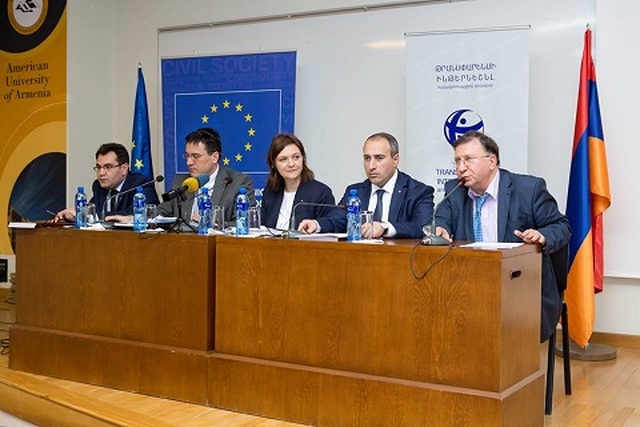The findings of “National Integrity System (NIS) Assessment Armenia 2014” research were presented
On April 30, 2015 Transparency international Anticorruption Center (TIAC) presented “National Integrity System (NIS) Assessment Armenia 2014” report, examining anti-corruption mechanisms and safeguards across 13 institutions in Armenia. The speakers of the event were H.E. Traian Hristea, Head of EU Delegation to Armenia, Suren Krmoyan, Deputy Minister of Justice of the Republic of Armenia, Elena Panfilova, Vice-Chair of Transparency International, the global anti-corruption organisation, Varuzhan Hoktanyan, TIAC Executive Director, author of the report, and Khachik Harutyunyan, main author of the report and Lead Researcher of the project. Video "National Integrity System" produced by TIAC was also screened during the event.
Varuzhan Hoktanyan presented NIS methodology, NIS concept, results and weaknesses of the pillars, including Legislature, President, Executive, Judiciary, Civil Service, Law Enforcement Agencies, Central Electoral Commission, Human Rights Defender, Chamber of Control, Political Parties, Media, Civil Society, and Business.
During the discussion the main speakers and author of the Business pillar and parts relating to public procurement, TIAC Procurement Policy Expert Artak Manukyan answered the questions discovering the reasons of identified weaknesses of pillars and ways for the implementation of the suggested recommendations.
The report “National Integrity System Assessment Armenia 2014” presents findings and results under the framework of the regional project, “National Integrity System Assessments in European Neighborhood East Region”, which is coordinated by Transparency International Secretariat and funded by the European Union in the amount of 756,129.93 euros (382,065,868 AMD). In Armenia the project is implemented and directed by TIAC and Executive Director Varuzhan Hoktanyan, with co-funding from Open Society Foundations Armenia. The regional project has been underway since March 2013, and the overall objective of the project is to improve good governance in the Neighborhood East region by decreasing corruption and ensuring adequate anti-corruption safeguards are in place.
The major findings of the study are:
- Despite having sufficiently well formulated anti-corruption legislation, there are serious shortcomings in its effective implementation.
- The judiciary remains corrupt and not free from the influence of the authorities.
- The prosecution for the corruption-related crimes is alarmingly low.
- In practice, for the most of the pillars, with some exceptions, there is lack of accountability, independence and integrity. At the same time, in practice, the level of transparency among the majority of the pillars is relatively high.
- Civil society and media remain very weak as watchdogs against corruption. They need fundamental reforms to become effective pillars of Armenian NIS.
Based on these and other findings, a number of recommendations aimed at strengthening the Armenian NIS are proposed, including:
1. Make reality the distinction between business and high level public officials.
2. Enhance prosecution of corruption offenses, in view of the fact that the statistics for the first half of 2013 revealed a very low number of prosecutions of corruption offences.
3. Make the Chamber of Control more independent by considering providing constitutional immunities for the members of the Chamber.
The results of the research are presented in the “National Integrity System Assessment Armenia 2014” publication (available in both English and Armenian).
See also "National Integrity System" video on TIAC website.





